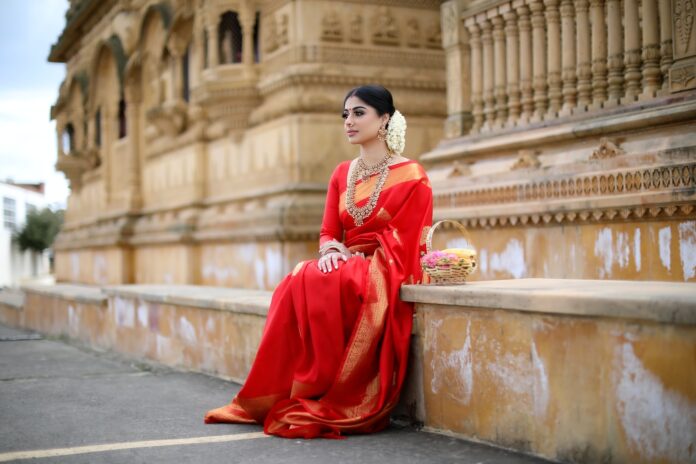
Sarees, with their timeless charm and elegance, have been an integral part of Indian culture for centuries. This iconic garment, worn by women across the country, embodies grace, tradition, and beauty. The journey of sarees through history is a fascinating one, showcasing the rich heritage and cultural diversity of India.
A journey through the evolution of sarees
The origins of sarees can be traced back thousands of years, making them one of the oldest known garments in the world. The earliest depictions of sarees can be found in ancient sculptures and paintings, showcasing women draped in elaborate and intricate fabrics. Initially, sarees were simple garments made from unstitched fabric, which were wrapped around the body in various ways. Over time, the saree evolved, taking on different regional styles and incorporating unique techniques and designs.
One of the most iconic and recognizable types of sarees is the Banarasi silk saree. Originating from the city of Varanasi in Uttar Pradesh, these sarees are known for their opulence, fine craftsmanship, and rich cultural heritage. Banarasi silk sarees are typically made from pure silk and are adorned with intricate designs, often featuring motifs inspired by Mughal art and architecture. The weaving of these sarees involves highly skilled artisans who meticulously create elaborate patterns using gold and silver threads, known as zari. Banarasi silk sarees have long been a symbol of luxury and are often worn on special occasions such as weddings and festivals.
Another notable style of saree is the Kanjeevaram saree, which hails from the town of Kanchipuram in Tamil Nadu. These sarees are renowned for their rich silk fabric, vibrant colours, and intricate borders. Kanjeevaram sarees are traditionally hand-woven, with each saree taking weeks or even months to complete. The weaving process involves interlacing three different threads – the warp, weft, and zari – resulting in sarees that are known for their durability and lustrous appearance. Kanjeevaram sarees are highly prized and are often passed down through generations as family heirlooms.
The diversity of India is beautifully reflected in the various regional sarees found across the country. From the vibrant Bandhani sarees of Gujarat and Rajasthan to the graceful Taant sarees of West Bengal, each region has its own unique style and technique. The Paithani sarees of Maharashtra are known for their exquisite hand-woven silk and intricate peacock motifs, while the Chanderi sarees from Madhya Pradesh are cherished for their lightweight fabric and delicate floral patterns. These regional sarees not only showcase the skill and creativity of local artisans but also serve as a visual representation of the cultural heritage of their respective regions.
Despite the influence of modern fashion trends, sarees have managed to retain their timeless charm and continue to be a favored choice for women across India. The versatility of sarees allows for various draping styles and combinations, making them suitable for both formal and casual occasions. From traditional silk sarees to contemporary designer sarees for women, there is a wide range of options available to cater to different tastes and preferences.
In recent years, sarees for women have also gained popularity on the global fashion stage. Designers and fashion enthusiasts from around the world have embraced the beauty and elegance of sarees, incorporating them into their collections and showcasing them in international fashion shows. This cross-cultural appreciation has further elevated the status of sarees, solidifying their position as a symbol of grace and sophistication.
Conclusion
The journey of sarees through history is a testament to their enduring charm and significance in Indian culture. From their humble beginnings as simple unstitched garments to the intricately woven masterpieces of today, sarees have evolved while preserving their timeless appeal. The rich variety of regional styles, the craftsmanship of skilled artisans, and the cultural diversity they represent make sarees a treasured part of India’s heritage. As women continue to embrace sarees, they contribute to the preservation and celebration of this traditional attire, ensuring that its beauty and grace will endure for generations to come.








